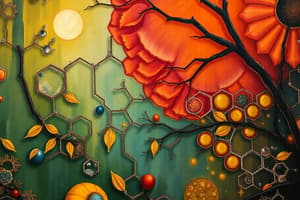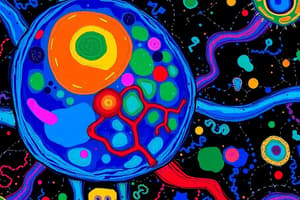Podcast
Questions and Answers
What function do tight junctions primarily serve in vertebrate tissues?
What function do tight junctions primarily serve in vertebrate tissues?
- To mechanically attach the cytoskeletons of adjacent cells
- To facilitate cellular communication through direct contact
- To aid in the transport of vesicular content into the nucleus
- To form barriers preventing the passage of molecules (correct)
Which type of endocytosis involves the uptake of large particles like bacteria?
Which type of endocytosis involves the uptake of large particles like bacteria?
- Exocytosis
- Phagocytosis (correct)
- Receptor-mediated endocytosis
- Pinocytosis
What characterizes paracrine signaling?
What characterizes paracrine signaling?
- Cells release signals that act on themselves
- Direct interaction occurs through cell membranes
- Signals travel long distances to reach target cells
- Signals act on neighboring cells within close range (correct)
In the context of chemical signaling, what is autocrine signaling?
In the context of chemical signaling, what is autocrine signaling?
What does the dissociation constant (Kd) measure?
What does the dissociation constant (Kd) measure?
What type of energy is associated with the movement of an object?
What type of energy is associated with the movement of an object?
Which protein type is responsible for transporting substances across the cell membrane without the use of energy?
Which protein type is responsible for transporting substances across the cell membrane without the use of energy?
What is an example of primary active transport?
What is an example of primary active transport?
Which type of energy is characterized by the heat produced?
Which type of energy is characterized by the heat produced?
Which junction allows diffusion of small molecules or ions between animal cells?
Which junction allows diffusion of small molecules or ions between animal cells?
What type of energy is found in atomic nuclei?
What type of energy is found in atomic nuclei?
What is the primary function of glycoproteins in the cell membrane?
What is the primary function of glycoproteins in the cell membrane?
Which energy type is related to the concentration of chemical substances or charges?
Which energy type is related to the concentration of chemical substances or charges?
What role do allosteric enzymes play in cellular processes?
What role do allosteric enzymes play in cellular processes?
Which statement accurately defines an inhibitor in the context of enzyme activity?
Which statement accurately defines an inhibitor in the context of enzyme activity?
What distinguishes an agonist from an antagonist in receptor activity?
What distinguishes an agonist from an antagonist in receptor activity?
What is a key function of the rough endoplasmic reticulum?
What is a key function of the rough endoplasmic reticulum?
Which statement about the products and reactants in a chemical reaction is correct?
Which statement about the products and reactants in a chemical reaction is correct?
What best describes potential energy in a chemical reaction?
What best describes potential energy in a chemical reaction?
What is the function of the Golgi apparatus in a cell?
What is the function of the Golgi apparatus in a cell?
What is a common misconception about the vacuole in plant cells?
What is a common misconception about the vacuole in plant cells?
What does Kd represent in the context of protein-ligand interactions?
What does Kd represent in the context of protein-ligand interactions?
Which type of receptor activates an intrinsic kinase activity upon ligand binding?
Which type of receptor activates an intrinsic kinase activity upon ligand binding?
Which class of enzymes is primarily responsible for breaking down molecules using water?
Which class of enzymes is primarily responsible for breaking down molecules using water?
What is the primary role of catalysts in chemical reactions?
What is the primary role of catalysts in chemical reactions?
Which of the following is an example of a transferase?
Which of the following is an example of a transferase?
What defines the transition state in a chemical reaction?
What defines the transition state in a chemical reaction?
Lyases are characterized by their ability to:
Lyases are characterized by their ability to:
Which of the following statements is true about equilibrium in a chemical reaction?
Which of the following statements is true about equilibrium in a chemical reaction?
What is the primary role of isomerases in biochemical reactions?
What is the primary role of isomerases in biochemical reactions?
During which stage of cellular respiration does oxidative phosphorylation primarily occur?
During which stage of cellular respiration does oxidative phosphorylation primarily occur?
What is the main input for glycolysis?
What is the main input for glycolysis?
What describes the saturation point in relation to enzyme activity?
What describes the saturation point in relation to enzyme activity?
Which substance is produced as an output of the citric acid cycle?
Which substance is produced as an output of the citric acid cycle?
What occurs during the process of chemiosmosis?
What occurs during the process of chemiosmosis?
What is the result of oxidation during aerobic cellular respiration?
What is the result of oxidation during aerobic cellular respiration?
Which of the following molecules is involved in the conversion of ADP to ATP?
Which of the following molecules is involved in the conversion of ADP to ATP?
Flashcards are hidden until you start studying
Study Notes
Allosteric Enzymes
- Regulated by molecules binding to sites other than the active site
- Binding causes conformational changes that activate or inhibit enzyme activity
Enzyme Inhibitors
- Decrease enzyme activity
- Block the active site or allosteric site
Enzyme Activators
- Increase enzyme activity
- Enhance enzyme function
Agonist
- Activates a receptor
- Mimics the natural signal
Antagonist
- Blocks the receptor
- Prevents activation
Endoplasmic Reticulum
- Largest internal membrane of a cell
- Contains the cisternal space
- Rough ER synthesizes proteins and adds carbohydrates to proteins to make glycoproteins
- Smooth ER synthesizes carbohydrates and lipids
- Smooth ER stores calcium, keeping intracellular calcium concentration low so calcium can function as a signaling molecule
Golgi Apparatus
- Sorts, packs, and distributes molecules within and outside the cell
- Modifies carbohydrates and/or adds them to proteins
Vacuole
- Makes up approximately 90% of the internal volume of a plant cell
- Stores waste products
- Maintains the internal structure of the cell
Chemical Reactions
- Reactants: What goes into the reaction (A+B)
- Product: What comes out of the reaction (AB)
- Yields: Symbol for the reaction going from reactants to product (→)
- Coefficients: Numbers in front of each reactant or product indicating the proportional amount
- Subscripts: Numbers after each element indicating the number of atoms of that element in the molecule
Energy
- The capacity of something to do work (force operating on an object over a distance)
- Biochemistry: energy is the capacity for change in chemical composition and molecular properties
Potential Energy
- Stored energy of a state or position
Kinetic Energy
- Energy of movement
Passive Transport Proteins
- Do not require chemical-bond energy for substance movement
- Movement occurs due to a concentration gradient
- Examples: channel proteins, carrier proteins
Active Transport Proteins
- Require energy from ATP to move molecules against a concentration gradient
- Primary Active Transport: Carrier proteins directly utilize ATP to move molecules
- Example: Sodium/Potassium pump
- Secondary Active Transport: Carrier proteins indirectly utilize ATP via proton pumps
- Example: Glucose uptake in the intestines
Cell Junctions:
- Additional membrane connecting structures forming after initial cell-cell binding
- Communicating junctions: Permit diffusion of small molecules or ions between cells to communicate with one another (Gap junctions, Plasmodesmata)
- Septate junctions: Prevent leakage of water and solutes between cells and form barriers (Tight junctions)
- Adhesive junctions: Mechanically attach cytoskeletons of cells to one another (Desmosomes)
Bulk Transport:
- Endocytosis: Cells engulf materials into the cell by forming vesicles from the plasma membrane
- Phagocytosis: "Cell eating" where large particles like bacteria are engulfed
- Pinocytosis: "Cell drinking" where fluids and dissolved solutes are taken in
- Receptor-mediated endocytosis: Specific molecules are ingested after binding to cell surface receptors
- Exocytosis: Cells expel materials out of the cell by fusing vesicles with the plasma membrane, releasing their contents to the extracellular space.
Chemical Signaling Systems:
- Autocrine: Cells release signaling molecules that act on themselves
- Juxtacrine: Occurs through direct contact between neighboring cells, where the signal molecule remains attached to the signaling cell's membrane and interacts with receptors on adjacent cells
- Paracrine: Cells release signaling molecules that act on nearby cells within a close range
Dissociation Constant (Kd):
- Measure of the affinity between two binding molecules (ligand and protein)
Classes of Signaling Receptors:
- Ligand-gated Ion Channels: Open or close in response to ligand binding, allowing ions to pass through the membrane
- Protein Kinase Receptors: Ligand binding activates their intrinsic kinase activity, which phosphorylates target proteins to trigger cellular responses
- G Protein-Coupled Receptors: Ligand binding activates an associated G protein, which then triggers downstream signaling pathways inside the cell.
Catalysts
- Speed up chemical reactions
- Do not determine whether a reaction occurs, only the rate of reaction
- Example: Enzymes
Transition States
- The point in which a molecule(s) are reactive
- Energy input is called activation energy (Ea)
Equilibrium
- A stable system where no reaction is taking place
Enzyme Classes
- Oxidoreductases: Transfer electrons between molecules
- Transferases: Transfer groups of atoms (functional groups) between molecules
- Hydrolases: Add water to covalent bonds to breakdown molecules
- Lyases: Catalyze breaking of non-hydrolytic bonds (splitting chemicals into smaller molecules without using water)
- Isomerases: Rearrangement of atoms within a molecule
- Ligases: Join two molecules together
Saturation Point
- The point in which all enzymes are bound to a substrate
Activation Energy
- The energy barrier that must be overcome for a reaction to proceed
Substrates
- The reactant or part that physically attaches to the enzyme protein which is then catalyzed by the enzyme
Glycolysis
- Input: Glucose, ATP (x2)
- Output: Pyruvate (x2), ATP (x2 net), NADH (x2)
Citric Acid Cycle
- Input: Acetate, water, GDP, NAD+, FAD
- Output: Carbon Dioxide, NADH, FADH2, GTP
Electron Transport Chain
- Input: NADH, FADH2, O2, H+ (protons), ADP, Phosphate
- Output: ATP, NAD+, FAD+, H2O
Oxidation
- Loss of electrons
- Happens during glycolysis when NAD+ becomes NADH and during the Citric Acid Cycle during steps 3, 4, 6, and 8
Reduction
- Gain of electrons
- Happens during fermentation when NADH becomes NAD+
Chemiosmosis
- Process where ATP is formed by combining a free-roaming phosphate group with a molecule of ADP, through the use of the enzyme ATP synthase.
- ATP synthase is powered by the passive diffusion of protons (H+) into the F0 unit.
- The F1 unit spins, mashing the ADP and phosphate group together.
- This process is done on the inner mitochondrial membrane.
- Utilizes the proton gradient from the intermembrane space of the mitochondria.
Receptor Antagonists vs. Agonists
- Antagonists: Block receptors, preventing activation
- Agonists: Activate receptors by mimicking natural ligands, triggering a biological response
Studying That Suits You
Use AI to generate personalized quizzes and flashcards to suit your learning preferences.




